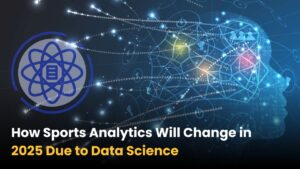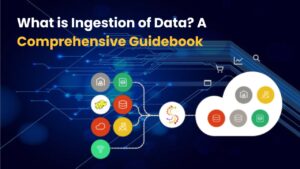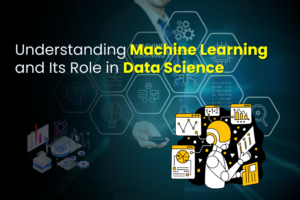The sports industry, once driven purely by instinct, tradition, and anecdotal performance, has undergone a seismic transformation in the 21st century. In 2025, data science is revolutionizing how teams compete, train, scout, recover, and even entertain. Sports analytics, powered by advances in machine learning, artificial intelligence (AI), wearable technology, and big data, is no longer a luxury—it’s a competitive necessity.
In this article, we’ll explore how sports analytics will change in 2025 due to data science across key domains—athlete performance, strategic gameplay, injury prevention, fan engagement, recruitment, and beyond.
1. The Rise of Intelligent, Context-Aware Sports Analytics
Moving Beyond Traditional Metrics
Historically, sports analytics relied on simple stats—goals scored, batting averages, assists, rebounds, etc. But in 2025, context-aware analytics takes center stage. Data science models consider environmental conditions, opponent strength, player fatigue, and even psychological states to deliver context-driven insights.
AI-Powered Game Understanding
Deep learning models now recognize complex patterns in video footage, understanding formations, momentum shifts, and tactical play structures. This AI-based “game IQ” empowers coaches with predictive game intelligence that was once unimaginable.
2. Real-Time Analytics in the Middle of the Action
Live Tactical Adjustments
Thanks to edge computing and ultra-low-latency data streaming, coaches and players receive real-time tactical feedback:
- Heat maps update live
- Player positioning is continuously analyzed
- AI recommends formation changes or substitutions mid-game
Example: In elite soccer matches, coaching tablets now suggest substitutions by analyzing opposing player fatigue levels and defensive errors in real time.
AI as the Assistant Coach
Virtual assistants powered by AI suggest in-game decisions based on simulations run millions of times using player-specific performance histories, weather, and opponent data.
3. Player Performance: Personalized, Predictive, and Precision-Oriented
Biometrics Meet Machine Learning
In 2025, wearables measure heart rate variability, skin temperature, blood oxygen levels, and joint strain. These data points feed predictive models that:
- Identify signs of overtraining
- Suggest training loads
- Detect potential injury before symptoms emerge
- Skill Acquisition Through Data Feedback
High-speed cameras and computer vision track every movement—from golf swings to basketball shots. Deep reinforcement learning suggests micro-adjustments to technique, offering personalized drills based on biomechanical inefficiencies.
Example: Tennis players now receive real-time swing feedback based on motion sensors embedded in rackets and wristbands.
4. Injury Prevention Becomes Data-Driven and Proactive
Predictive Injury Modeling
Machine learning algorithms built on years of training, game, and medical data can now anticipate injuries days or even weeks before they occur. These
Models detect patterns that humans might miss, like increased ground contact time or reduced acceleration.
- Real-Time Health Dashboards
- Sports medicine teams use dashboards showing:
- Recovery indexes
- Tissue fatigue scores
- Asymmetry in motion (e.g., favoring one leg over another)
to ensure athletes train and recover safely.
Outcome: Reduced injury rates and prolonged careers, especially in high-impact sports like rugby and football.
5. Tactical Game Modeling: Winning Through Data
Pre-Game Simulations
Before major games, data science teams simulate thousands of game outcomes based on team lineups, past matchups, playing styles, and environmental factors. These simulations inform starting lineups and formations.
Strategy Trees and Playbooks
Machine learning now powers dynamic “strategy trees”—a “constantly evolving set of conditional plays based on opponent moves.” Coaches can prepare for every possible scenario using these predictive playbooks.
Example: In American football, offensive coordinators use AI-driven strategy trees to decide plays based on down-and-distance probabilities and defensive alignment patterns.
Your Data Science Dream Career Starts in Pune—Enroll Today & Learn from Top Mentors!
6. Scouting and Talent Identification in the Era of AI
Global Talent Pools Analyzed by Algorithms
AI scouts scour leagues worldwide, analyzing player statistics, biomechanics, injury history, and even personality traits from social media to identify hidden talent. Clubs use similarity models that compare unknown players to proven stars.
Example: A young cricket player from a Tier 2 city in India might get discovered because their stats align with a historical profile of a successful player.
Virtual and Augmented Reality Scouting
In 2025, scouts can immerse themselves in virtual recreations of matches from different angles and simulate how a new player would fit within the current team.
7. Fan Experience: A Data-Personalized Journey
Hyper-Personalized Content and Experiences
Teams use data from social media, in-app behavior, and ticket purchases to:
- Deliver personalized highlight reels
- Recommend merchandise
- Offer AR-based stadium navigation
- Real-Time Stats for Enhanced Engagement
Fans now access real-time player data during matches on mobile apps and stadium screens.
- Live win probabilities
- Shot maps
- Performance comparisons
Fantasy leagues and sports betting platforms integrate this data to offer predictive insights, increasing fan engagement and revenue.
8. The Economics of Sports: Data Science in Business Decisions
Revenue Forecasting and Ticket Pricing
Dynamic pricing algorithms adjust ticket prices based on demand, weather, star players’ participation, and even social media buzz. Data science helps franchises maximize revenue without alienating fans.
Sponsorship Impact Analysis
Teams use AI to evaluate the ROI of sponsorships by analyzing
- Fan sentiment
- Brand visibility on social media
- In-game camera exposure time
9. Women’s Sports and Data Parity
Data science in 2025 plays a crucial role in elevating women’s sports by
- Providing equal access to performance analytics
- Tracking athlete development at grassroots levels
- Promoting visibility through data-driven media coverage
Teams now measure not just athletic metrics but also marketability, helping close the exposure and investment gap.
10. Democratization of Sports Analytics
Tools for Amateur Athletes
Thanks to open-source libraries and affordable wearables, amateur athletes and high school coaches now have access to data tools once reserved for professionals:
- Python notebooks for video analysis
- Free dashboards like Tableau Public
- Motion sensors for swing or sprint analysis
Education and Certification
Courses in sports analytics and data science are now standard in sports management and data science degrees, creating a new class of hybrid professionals.
11. Ethical and Privacy Considerations in 2025
As data collection becomes more invasive, 2025 brings heightened awareness of privacy rights and ethical concerns:
- Who owns player biometric data?
- Can a player refuse to wear a tracker?
- Should AI decide team selection?
Regulations such as GDPR and sports-specific compliance laws are evolving to protect stakeholders and maintain data integrity.
Your Data Science Dream Career Starts in Pune— Enroll Today
12. Challenges Ahead for Data Science in Sports
Data Quality: Sensor errors and inconsistent data labeling still plague some systems.
Model Interpretability: Coaches demand clear, explainable insights, not black-box predictions.
Resistance to Change: Traditionalists in some sports still question the role of data over intuition.
13. Case Studies of 2025 Innovations
a. NFL’s AI-Driven Play Calling
Teams use predictive analytics to script opening drives
Player injury risk scores are updated every quarter
b. Indian Premier League (IPL) and Fan Data
AI creates personalized video recaps for each viewer
Predictive models suggest match outcomes during commercial breaks
c. Olympics and Athlete Monitoring
Wearables used for hydration monitoring in marathons
Biomechanical analysis in gymnastics for scoring fairness
14. The Future: What’s Coming After 2025?
a. Emotion AI in Sports
Advanced models will soon analyze facial expressions and speech to assess an athlete’s emotional state and mental readiness.
b. Neuroanalytics
Wearables may analyze brainwaves to assess decision-making and reaction speed, especially in high-stakes sports like racing or fencing.
c. Synthetic Training Environments
Simulations with haptic feedback and AI opponents will replace parts of physical training, reducing injury and accelerating skill acquisition.
Conclusion:
As we stand in 2025, the convergence of data science and sports is not just a trend—it’s the new norm. Every aspect of sports—from tactics to training and from business to broadcasting—is being reshaped by intelligent, data-informed systems. This isn’t about replacing human judgment but augmenting it with precision, personalization, and performance optimization.
The greatest wins of the future won’t just happen on the field, but also in the datasets, models, and insights that teams learn to trust. Sports analytics, supercharged by data science, has become the ultimate playmaker in the modern game.






